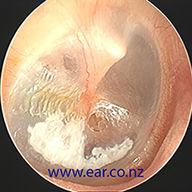Clinic Hours: Monday – Friday - 8am - 5pm
Phone: 09 631 1965
Email: office@ear.co.nz
Conditions
Ear Drum Repair
What is a Myringoplasty?
A myringoplasty is an operation to repair a hole in the ear drum ("perforated ear drum"). Most often, this is a straightforward procedure, with minimal discomfort, and no requirement for an overnight stay in hospital.
How did I get a hole in my eardrum?
The most common causes of perforated eardrum are:-
a) Acute ear infections (burst eardrum)
b) Trauma (slapping over the ear, falling "ear first" into water,explosion)
c) Following grommet treatment for middle ear infections and glue ear
How is the Operation Performed?
The operation is performed usually under a general anaesthetic (asleep), although in some adults this may be performed under local anaesthetic (awake). This is typically performed through the ear canal (a 'trans- canal myringoplasty') using a microscope or an endoscope (" endoscopic myringoplasty"), or through an incision or cut made immediately in the skin crease behind the ear (a 'post auricular myringoplasty'). Sometimes the ear canal needs to be enlarged to enable good visual access to the front of the ear drum.
The repair tissue may consist of fat (from under the skin in the hairline of the upper neck) , from the lining of the muscle from behind the ear, or the lining of the cartilage (perichondrium) from in front of the ear (the tragus). Under microscopic or endoscopic visualisation, the perforation margins are freshened. In some cases incisions are made in the ear canal and the back of the ear drum is elevated. The hearing bones (ossicles) are then checked. When a fat graft is used, this is inserted through the perforation and carefully dressed with a dressing. There are no additional stitches (apart from up to 2 dissolving stitches at the hairline fat 'donor' site)
If temporalis muscle fascia or perichondrium are used, the tissue is then inserted under the perforation and held in place with dissolving sponge. Dressings are then placed in the ear canal for a period of approximately three weeks. The sponge inside the ear dissolves over a period of a month to six weeks. There are dissolving stitches inserted either in front of the ear, or behind the ear.
A check up is made three, five and approximately 9 weeks after the operation.
Are There Risks of the Operation?
The success rate for permanent closure of the hole is approximately 80 percent, irrespective of the size of the perforation, or your age. Risks of the surgery are small in experienced hands but include:
-
Wound infection (less than 1%)
-
Inner ear hearing loss (less than 0.5%, but never reported in fat graft repairs)
-
Glue ear: Typically temporary- as a result of unexpected poor maturation of the eustachian tube
-
Persisting hearing loss due to scar tissue in the middle ear (up to a few %)
-
Temporary reduction in sense of taste on the tongue due to stretching or damage to the chorda tympani (taste nerve) which runs though the middle ear (up to a few % in temporalis fascia and tragal perichondrial repairs, but 0% in fat graft repairs)
-
Cholesteatoma: an implantation of skin from the surface of the ear drum into the middle ear. May result in failure of the ear drum to heal, or a discharging ear. This may occur in several %. It is important to check the ear at 6 and 12 months post op to identify and treat this.
How do I Make Arrangements to have the Operation?
If you would like to make a booking to have the ear drum repaired, we will make arrangements for you.
The procedure is performed at Southern Cross Gillies Hospital, Epsom, Auckland. In most cases it is possible to return home 3-4 hours afterwards (2 hours after a fat graft). There is only modest discomfort requiring paracetamol and an anti inflammatory medication.
No food should be eaten from midnight the night before your operation, and no fluids taken for four hours before the procedure.
It is common to have some bleeding from the ear for a few days following the operation (less so with a fat graft). This can be easily controlled by changing cotton wool in the ear hole on a regular basis as necessary.
Sport should be deferred for 3 weeks post op and the ear should remain dry at least 5 weeks.
If you have further questions, please do not hesitate to ask! We are here to make your operation safe, effective and as comfortable as possible.





